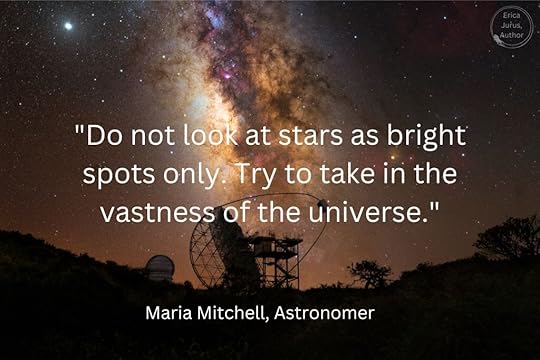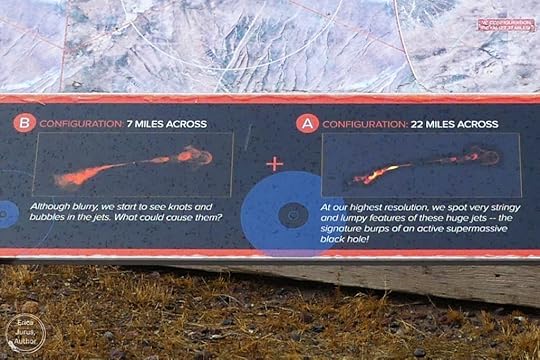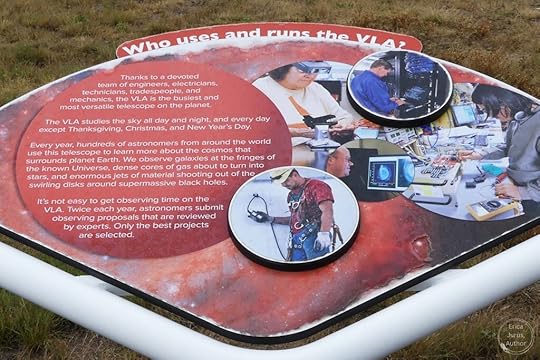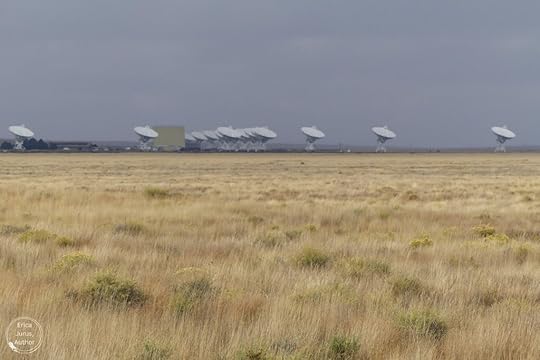Searching the Stars

This week we look out to the stars. What’s really out there, besides what we can see when we look up at the night sky?
For thousands of years, humans have been paying attention to both the life- and warmth-giving sun during the day, and what was revealed above us after the sun set. They noticed the changes in the moon throughout the lunar months, as well as clusters of stars that they thought resembled animal shapes. There are cave paintings 30,000 years old that depict their observations.
There were constants, like the Big Dipper and Orion, that allowed sailors to navigate the seas. Star charts were being created more than 1,000 years BCE.
It’s believed the Babylonians observed the passage of Halley’s Comet. Life in ancient Egypt depended on the flooding of the Nile River to grow crops, and when the people discovered that the event recurred about every 365 days, they created the first calendar very similar to ours. Indigenous North Americans oriented stone markers to the Sun and stars so they could chart the arrival of summer, while southward, the Mayans built special buildings to make astronomical observations and by 800 A.D. had a calendar more accurate than the one used in Europe.
Clearly the heavens have been on our minds for millennia, allowing us to make calculations about what was coming throughout the year. But beyond that, inventors began producing telescopes in the Middle Ages, allowing them to look further than the naked eye.
During the Renaissance, astronomer Giordano Bruno was the first to suggest that all those twinkly stars in the blackness of the firmament were distant suns. He also believed in intelligent life out there, which earned him the attentions of the Inquisition, unfortunately. But work began in earnest about what exactly was up there, and it hasn’t abated any time since.
In the 19th century, scientists discovered that there were forms o light we couldn’t see – gamma rays, UV radiation, radio waves…
It was an American physicist who in 1933 discovered radio waves emanating from the Milky Way, and the science of radio astronomy was born.
Radio astronomy is another way of making observations about the universe than using visual cues. According to the National Radio Astronomy Observatory (NRAO):
“There’s a hidden universe out there, radiating at wavelengths and frequencies we can’t see with our eyes. Each object in the cosmos gives off unique patterns of radio emissions that allow astronomers to get the whole picture of a distant object. Radio astronomers study emissions from gas giant planets, blasts from the hearts of galaxies, or even precisely ticking signals from a dying star.”
The NRAO is headquartered in Virginia, but it oversees radio telescopes in numerous locations. Probably the most famous of these is the Very Large Array (VLA) in Socorro, New Mexico. Actress Jodie Foster’s character, Ellie Arroway, spent a lot of time there in the 1997 movie Contact, based on the novel by Carl Sagan.
 During our visit to the Very Large Array, the antennas were clustered together. Photo by E. Jurus, all rights reserved.
During our visit to the Very Large Array, the antennas were clustered together. Photo by E. Jurus, all rights reserved.“Who are we? We find that we live on an insignificant planet of a humdrum star lost in a galaxy tucked away in some forgotten corner of a universe in which there are far more galaxies than people.” Carl Sagan
The New Mexico array is named after the man now considered a founding father in radio astronomy, none other than Karl Jansky. His discovery of radio waves was one of those ‘happy accidents’ that he recognized the importance of. At the age of 22, he was hired by Bell Telephone Labs to investigate short waves and whether their static might interfere with radio transmissions here on earth.
He built a directional antenna about 100 feet in diameter, mounted on a turntable with a set of four wheels from a Model-T Ford car, allowing him to rotate the antenna to determine the direction of signals it received. After spending several months recording signals from many directions, Jansky grouped them into the following: static from nearby thunderstorms, storms farther away, and something of unknown origin.
Jansky spent over a year trying to figure out the third kind. At first it seemed to come from the sun, but after a few months it moved away from that position. And it repeated, on a cycle of 23 hours and 56 minutes. After consulting with an astrophysicist, Albert Skellett, and comparing his observations with astronomical maps of the time (which were based on optical data), Jansky concluded that the radiation came from out in the Milky Way. He called it “Star Noise”.
He announced his discovery at the time, but few people understood the significance, and his requests to investigate further got little support, especially not financially from Bell Labs, who were directing their dollars towards trans-Atlantic communications.
A few scientists were interested, but the concept of “radio” astronomy didn’t catch on for several years, partly because it was the Great Depression at the time and funding wasn’t forthcoming, and because Jansky didn’t have strong credentials – only a Bachelor of Physics. However, in 1937 a radio engineer named Grote Reber built a radio telescope in his back yard and began conducting radio-wave research, followed by John Kraus, who built a radio observatory at Ohio State University after WW2.
Imagine the wonders that this new method of astronomical research began to reveal. Kraus himself said,
“In 1930 essentially all that we knew about the heavens had come from what we could see or photograph. Karl Jansky changed all that. A universe of radio sounds to which mankind had been deaf since time immemorial now suddenly burst forth in full chorus.”
You can visit the Very Large Array in New Mexico, and it’s a fascinating place. My hubby and I were lucky enough to be in the area in the fall of 2022, just a week after the Array reopened to the public post-pandemic.
We practically had the place to ourselves. It was a rainy day, but we bundled up, toured the extensive information provided in the Visitor Centre, and then were allowed to wander all over pretty freely, right out to the closest of the 28 radio telescopes. There were signs with even more information at each stop on the self-guided tour.
They’re not small items. The receiving dishes are 82 feet across, and each antenna, including the complex base it’s mounted on, weighs 209 metric tons.
 To give you an idea of the size of the antennas, I’m standing at the bottom of one, below the stairs on the front left of the photo, in an off-white jacket and pants. Photo by M. Jurus, all rights reserved.
To give you an idea of the size of the antennas, I’m standing at the bottom of one, below the stairs on the front left of the photo, in an off-white jacket and pants. Photo by M. Jurus, all rights reserved.Twenty-seven of the antennas are ranged along the arms of a Y-shaped track, and can be moved around into different configurations to suit the needs of the researchers. The array basically acts as a single antenna whose ‘diameter’ can be changed by drawing its 27 components either closer together or farther apart. They can be sent as far apart as 22 miles or all pulled within one mile at the closest alignment.
 Photo by E. Jurus, all rights reserved.
Photo by E. Jurus, all rights reserved.When we visited, the Array was in Configuration “C”. the second smallest.
 Photo by E. Jurus, all rights reserved.
Photo by E. Jurus, all rights reserved.The antennas were resting on their stationary foundations, which may not look like much, but they rise 6’4” above the ground, and another 32’ below to hold up their massive burdens.
 Photo by E. Jurus, all rights reserved.
Photo by E. Jurus, all rights reserved.There is a 28th antenna, kept as a spare. When we visited, one out on the Y was looking wonky – it was pointing straight upward instead of at a specified angle, what the staff amusingly referred to as “bird nest” mode – and there was another in the on-site repair shop, perhaps waiting to be deployed.
 The ‘bird-nest’ antenna. They seem to have a mind of their own on occasion. Photo by E. Jurus, all rights reserved.
The ‘bird-nest’ antenna. They seem to have a mind of their own on occasion. Photo by E. Jurus, all rights reserved. Spare antenna in the on-site garage. Photo by E. Jurus, all rights reserved.
Spare antenna in the on-site garage. Photo by E. Jurus, all rights reserved.The Array achieves an impressively detailed resolution across immense distances of space: as fine as between 0.2 and 0.04 arcseconds. To put that into context, an arcminute is a unit of measurement equal to 1/60th of one degree, i.e. of a full circle. An arcsecond is even tinier, 1/60th of that.
 A section of one of the explanatory signs out on the tour, explaining what can be ‘seen’ at different configurations. Photo by E. Jurus, all rights reserved.
A section of one of the explanatory signs out on the tour, explaining what can be ‘seen’ at different configurations. Photo by E. Jurus, all rights reserved.The scientists conducting research generally aren’t on site – they submit projects from all over to the Array and request use of the antennas. Operators at the site maneuver the antennas and relay the results to the relevant scientists. Nobody lying around on the hood of a car with headphones – sorry.
 Photo by E. Jurus, all rights reserved.
Photo by E. Jurus, all rights reserved.The Array was built in the 1970s, then tweaked in 2011 to allow new technology. It remains the most powerful and most flexible instrument of its kind. According to the NRAO, more than 3,700 planets in 2,700 star systems have been confirmed, and scientists have been able to follow radio waves all the way back to the afterglow following the Big Bang.
And starting early this year, the Array is getting a major facelift. It will become the Next Generation Very Large Array (ngVLA). Construction on a prototype antenna dish will begin in this very month; it’s expected to take an entire year, followed by the building of more than 200 additional new antennas over the next dozen years or so. The old dishes will stay online while the next generation is developed.
The current construction estimate for the ngVLA is $2.3 billion, and it’s expected to cost $93 million per year in operational costs once it comes online, but the new version may be able to do things like shed new light on how planets form. The new antennas will be lighter, smaller, and less expensive to construct and maintain than the original dishes. In addition, they won’t need to move on tracks, as they currently do every four months (either pulled together for observing large-scale structures or pushed apart to see detail, but not both aspects at the same time).
We were able to see, and stand on, the miles of track that the big dishes chug around on; we’d have loved to see them on ‘moving’ day! Nevertheless, we felt privileged to have such an up-close-and-personal look at such an amazing research instrument that lets our world see far, far out into the heavens to find out what people have been wondering for such a long time: what’s out there?
 Some of the miles of track that the antennas move around on. Photo by E. Jurus, all rights reserved.
Some of the miles of track that the antennas move around on. Photo by E. Jurus, all rights reserved.On January 8 just this year, an international team of astronomers announced that they’ve found a mysterious star formation at the far edge of the galaxy M83. The research used several instruments, including the Karl G. Jansky Very Large Array (VLA). One of the things researchers do is look for “molecular clouds” – the evidence of formation of new stars. This team discovered 23 molecular clouds that showed a different type of star formation, providing an important clue to the physical processes that lead to star formation in general. They’re very excited.
Also on January 8th, it was announced that the SETI Institute’s COSMIC project (“Commensal Open-Source Multimode Interferometer Cluster”, if you were wondering) at the Very Large Array is expanding the search for extraterrestrial intelligence (SETI). How cool is that?! The COSMIC cluster is specially designed for future upgrades, allowing it to do much more than search for extraterrestrial intelligence – to finding more stars, exploring new radio wave frequencies, and studying all kinds of leading-edge concepts like dark matter.
If you’re interested in learning more about SETI, check out its posting A Primer on SETI at the SETI Institute. And while everyone conducts amazing research, you can visit the Array personally, as we did. It’s open 362 days a year (closed on Thanksgiving, Christmas Day, and New Year’s Eve), daily from 9 a.m. to 4 p.m., and you can take the same self-guided tour we did, that ends at the base of one of the giant antennas. Visit public.nrao.edu/visit/very-large-array for information.
We stayed in Socorro, where most of the VLA staff live. The drive out to the Array is easy along paved roads, and runs through some wonderful New Mexico scenery. You can see the Array from the main road, and it becomes even cooler when you turn off onto the property and all the antennas start coming into view. I don’t know if you can find out in advance the days that the antennas are moved around (they were listed on a poster when we visited), but that would indeed be something to see.
“I want to know what dark matter and dark energy are comprised of. They remain a mystery, a complete mystery. No one is any closer to solving the problem than when these two things were discovered.” Neil deGrasse Tyson
N.B. Re my January 16th post: I came across a full episode of the Expedition Unknown TV series with explorer Josh Gates dedicated to Tiwanaku, and it’s excellent. Atlantis of the Andes, S6.E3.
 View from the road the day we were there. Photo by E. Jurus, all rights reserved.
View from the road the day we were there. Photo by E. Jurus, all rights reserved.The post Searching the Stars first appeared on Erica Jurus, author.



